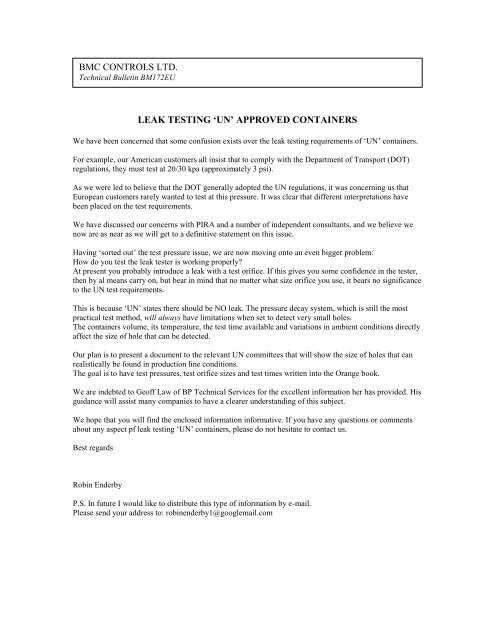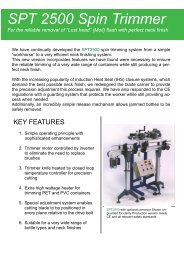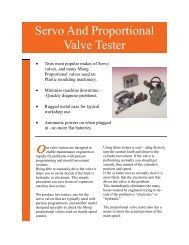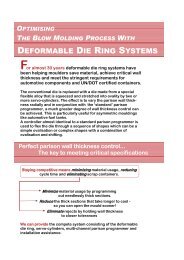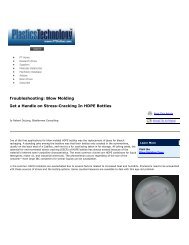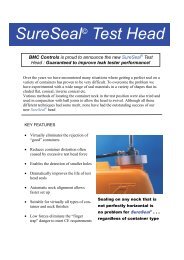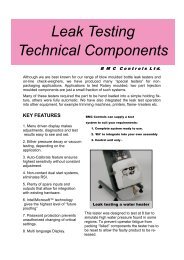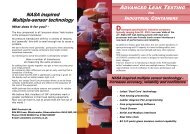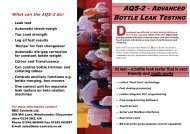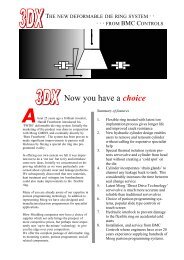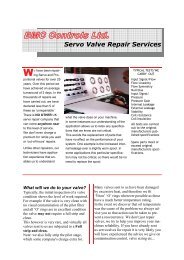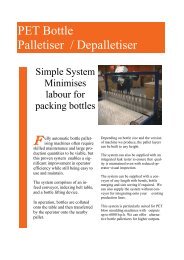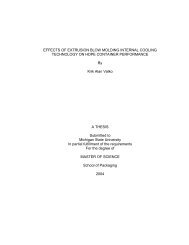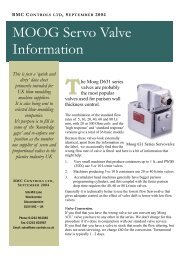leak testing 'un' approved containers - Blow Moulding Controls
leak testing 'un' approved containers - Blow Moulding Controls
leak testing 'un' approved containers - Blow Moulding Controls
Create successful ePaper yourself
Turn your PDF publications into a flip-book with our unique Google optimized e-Paper software.
BMC CONTROLS LTD.<br />
Technical Bulletin BM172EU<br />
LEAK TESTING ‘UN’ APPROVED CONTAINERS<br />
We have been concerned that some confusion exists over the <strong>leak</strong> <strong>testing</strong> requirements of ‘UN’ <strong>containers</strong>.<br />
For example, our American customers all insist that to comply with the Department of Transport (DOT)<br />
regulations, they must test at 20/30 kpa (approximately 3 psi).<br />
As we were led to believe that the DOT generally adopted the UN regulations, it was concerning us that<br />
European customers rarely wanted to test at this pressure. It was clear that different interpretations have<br />
been placed on the test requirements.<br />
We have discussed our concerns with PIRA and a number of independent consultants, and we believe we<br />
now are as near as we will get to a definitive statement on this issue.<br />
Having ‘sorted out’ the test pressure issue, we are now moving onto an even bigger problem:<br />
How do you test the <strong>leak</strong> tester is working properly?<br />
At present you probably introduce a <strong>leak</strong> with a test orifice. If this gives you some confidence in the tester,<br />
then by al means carry on, but bear in mind that no matter what size orifice you use, it bears no significance<br />
to the UN test requirements.<br />
This is because ‘UN’ states there should be NO <strong>leak</strong>. The pressure decay system, which is still the most<br />
practical test method, will always have limitations when set to detect very small holes.<br />
The <strong>containers</strong> volume, its temperature, the test time available and variations in ambient conditions directly<br />
affect the size of hole that can be detected.<br />
Our plan is to present a document to the relevant UN committees that will show the size of holes that can<br />
realistically be found in production line conditions.<br />
The goal is to have test pressures, test orifice sizes and test times written into the Orange book.<br />
We are indebted to Geoff Law of BP Technical Services for the excellent information her has provided. His<br />
guidance will assist many companies to have a clearer understanding of this subject.<br />
We hope that you will find the enclosed information informative. If you have any questions or comments<br />
about any aspect pf <strong>leak</strong> <strong>testing</strong> ‘UN’ <strong>containers</strong>, please do not hesitate to contact us.<br />
Best regards<br />
Robin Enderby<br />
P.S. In future I would like to distribute this type of information by e-mail.<br />
Please send your address to: robinenderby1@googlemail.com
BMC CONTROLS LTD.<br />
Technical Bulletin BM172EU<br />
Leak Testing ‘UN’ Approved Containers<br />
It is clear from the UN regulations – see 6.1.1.3 (attached) that it is mandatory for each<br />
single package to be tested.<br />
However it is not intended that this test in every single package is the Leakproofness test<br />
as described in 6.1.5.4.3. This is a ‘Type Test’ for a package design type.<br />
However it is easy to see how the two are confused in other regulations e.g. ADR road<br />
regulations Appendix A.5.3561 (also attached).<br />
The USA DOT 49CFR regulations do appear to specify a minimum pressure for the<br />
production <strong>testing</strong>.<br />
This might all be clarified by a CEN / ISO working group which has a work item to<br />
develop a standard for Leakproofness <strong>testing</strong>.<br />
This working group (CEN TC261/SC1/WG6 also ISO TC122/SC3/WG8) has been<br />
working for a number of years on standardisation of issues relating to dangerous goods<br />
packaging <strong>testing</strong>. One of the issues being addressed is that the UN recommendations are<br />
loosely written and subject to variable interpretation. The development of these standards<br />
is hoped to lead to a ‘more level playing field’.<br />
Good progress has been made on a number of these standards and some, e.g. the Package<br />
Testing ISO 16104, which includes the Type Test for Leakproofness <strong>testing</strong>, are out for<br />
public comment.<br />
However, the work on ISO 16105 has not started yet!<br />
The UK has adopted a hands off approach to this, feeling that the lack of definition here<br />
does allow flexibility in the type of <strong>leak</strong> detection used in production.
6.1.1.3 Every packaging intended to contain liquids shall successfully undergo a suitable <strong>leak</strong>proofness test,<br />
and be capable of meeting the appropriate test level indicated in 6.1.5.4.3:<br />
(a)<br />
(b)<br />
Before it is first used for transport;<br />
After remanufacturing or reconditioning, before it is re-used for transport.<br />
For this test, packagings need not have their own closures fitted.<br />
The inner receptacle of composite packagings may be tested without the outer packaging provided<br />
the test results are not affected. This test is not necessary for inner packagings of combination packagings.<br />
6.1.5.4.3 Test method and pressure to be applied: the packagings including their closures shall be restrained<br />
under water for 5 minutes while an internal air pressure is applied, the method shall not affect the results of<br />
the test.<br />
The air pressure (gauge) to be applied shall be:<br />
Packaging Group 1 Packaging Group 11 Packaging Group 111<br />
Not less than<br />
30 kPa (0.3 bar)<br />
Not less than<br />
20 kPa (0.2 bar)<br />
Not less than<br />
20 kPa (0. bar)<br />
Other methods at least equally effective may be used.<br />
6.1.5.4.4 Criterion for passing the test: there shall be no <strong>leak</strong>age<br />
6.1.5.5 Internal pressure (hydraulic) test<br />
6.1.5.5.1 Packaging to be tested: the internal pressure (hydraulic) test shall be carried out on all design types<br />
of metal, plastics and composite packagings intended to contain liquids. This test is not required for inner<br />
packagings of combination packagings.
ADR (Road Transport) regulation<br />
B. Leakproofness test for all new, remanufactured or reconditioned packagings intended<br />
to contain liquids.<br />
3561 (1) Application of the test<br />
Every packaging intended to contain liquids shall successfully undergo a suitable<br />
<strong>leak</strong>proofness test<br />
- before it is first used for carriage<br />
- After remanufacturing or reconditioning, before it is re-used for carriage.<br />
For this test, packagings need not have their own closures fitted.<br />
The inner receptacle of composite packagings may be tested without the outer packaging<br />
provided the test results are not affected.<br />
The test is not required for:<br />
- inner packagings of combination packagings;<br />
- inner receptacles of composite packagings (glass, porcelain or stoneware)<br />
conforming to marginal 3510 (2)<br />
- removable head packagings intended for substances with a viscosity at 23 º C<br />
exceeding 200mm²/s;<br />
- light gauge metal packagings conforming to marginal 3510 (2)<br />
(2) Test method:<br />
Compressed air shall be introduced through the filling orifice of each packaging. The<br />
packaging shall be immersed in water; it shall be kept under water in such a way as not to<br />
distort the result of the test. The packaging may also be covered with soap solution, heavy oil<br />
or other suitable liquid on its seams or at any other place where <strong>leak</strong>age occurs. Other methods<br />
at least equally effective may also be used.<br />
Packagings need not be equipped with their own closures.<br />
(3) Air pressure to be applied:<br />
Packing group 1 Packing group 11 Packing group 111<br />
Not less than 30 kPa Not less than 20 kPa Not less than 20 kPa
178.604 Leakproofness test.<br />
(a) General. The <strong>leak</strong>proofness test must be performed with compressed air or other suitable<br />
gases on all packagings intended to contain liquids, except that:<br />
(1) The inner receptacle of a composite packaging may be tested without the outer<br />
packaging provided the test results are not affected; and<br />
(2) This test is not required for inner packagings of combination packagings.<br />
(b) Number of packagings to be tested-<br />
(1) Production <strong>testing</strong>. All packagings subject to the provisions of this section must be<br />
tested and must pass the <strong>leak</strong>proofness test:<br />
(i) Before they are first used in production<br />
(ii) Prior to reuse, when authorized for reuse by 173.28 of this subchapter.<br />
(2) Design qualification and periodic <strong>testing</strong>. Three samples of each different packaging<br />
must be tested and must pass the <strong>leak</strong>proofness test. Exceptions for the number of<br />
samples used in conduction the <strong>leak</strong>proofness test are subject to the approval of the<br />
Associate Administrator for Hazardous Materials Safety.<br />
(c) Special preparation –<br />
(1) For design qualification and periodic <strong>testing</strong>, packagings must be tested with<br />
closures in place. For production <strong>testing</strong>, packagings need not have their closures in<br />
place. Removable heads need not be installed during production <strong>testing</strong>.<br />
(2) For <strong>testing</strong> with closures in place, vented closures must either be replaced by similar<br />
non-vented closures or the vent must be sealed.<br />
(d) Test method. The packaging must be restrained under water while an internal air pressure is<br />
applied; the method of restraint must not affect the results of the test. The test must be<br />
conducted for other than production <strong>testing</strong>, for a minimum time of five minutes. Other<br />
methods, at least equally effective, may be used in accordance with Appendix B of this part.<br />
(e) Pressure applied. An internal air pressure (gauge) must be applied to the packaging as<br />
indicated in the following packing groups:<br />
(1) Packing Group 1: Not less than 30 kPa (4 psi)<br />
(2) Packing Group 11: Not less than 20 kPa (3psi)<br />
(3) Packing Group 111: (Not less than 20 kPa (3psi)<br />
(f) Criteria for passing the test. A packaging passes the test if there is no <strong>leak</strong>age from the<br />
packaging.<br />
178.605<br />
(a) General. One hydrostatic pressure test must be conducted for the qualification of all metal,<br />
plastic, and composite packaging design types intended to contain liquids and be performed<br />
periodically as specified in 178.601(e). This test is not required for inner packagings of<br />
combination packagings. For internal pressure requirements for inner packaging of<br />
combination packagings intended for transportation by aircraft, see 173.27(c) of this<br />
subchapter.<br />
(b) Number of test samples. Three test samples are required for each different packaging. For<br />
packagings constructed of stainless steel, monel, or nickel, only one sample is required for<br />
periodic re<strong>testing</strong> of packagings. Exceptions for the number of aluminium and steel sample<br />
packagings used in conducting the hydrostatic pressure test are subject to the approval of the<br />
Associate Administrator for Hazardous Materials Safety.<br />
(c) Special preparation of receptacles for <strong>testing</strong>s, Vented closures must either be replaced by<br />
similar non-vented closures or the vent must be sealed.<br />
(d) Test method and pressure to be applied. Metal packagings and composite packagings other<br />
than plastic (e.g., glass. Porcelain or stoneware), including their closures must be subjected to<br />
the pressure test for 5 minutes. Plastic packagings and composite packagings (plastic<br />
material), including their closures must be subjected to the test<br />
Page 792


